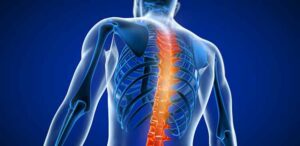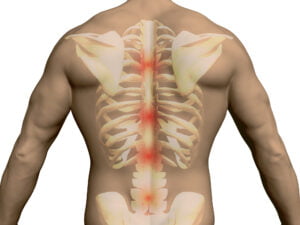Back pain is a prevalent condition that affects people of all ages and lifestyles. One specific area of the back that can experience discomfort is the thoracic region, located in the upper and middle back. Thoracic back pain can significantly impact a person’s daily activities and quality of life. In this blog, we will delve into the common causes of thoracic back pain and explore various treatment options to alleviate the discomfort and promote overall spinal health.
Contents
Understanding Thoracic Anatomy and Spine

Understanding thoracic anatomy is essential for comprehending the structure and function of the chest area, which includes the thorax, ribs, sternum, and associated organs. The thoracic cavity contains vital organs such as the heart, lungs, and major blood vessels, making it a crucial region for respiration and circulation.
The human spine is composed of three main regions: cervical (neck), thoracic (upper and middle back), and lumbar (lower back). The thoracic spine is made up of twelve vertebrae (T1 to T12) that connect the rib cage and provide support to the upper body. The thoracic region is designed for the stability and protection of vital organs, which limits its range of motion compared to the lumbar and cervical regions.
Understanding thoracic anatomy is essential for medical professionals, as it aids in diagnosing and treating various conditions related to the chest area, including respiratory and cardiovascular issues. It also helps in the interpretation of imaging studies, such as X-rays and CT scans of the chest.
Common Causes of Thoracic Back Pain
Thoracic back pain refers to discomfort or pain experienced in the middle and upper back region, known as the thoracic spine. Several factors can contribute to thoracic back pain, and some of the common causes include:
- Muscle Strain or Sprain: Overuse, poor posture, or sudden movements can strain or sprain the muscles and ligaments in the thoracic region, leading to localized pain.
- Poor Posture: Prolonged slouching, hunching over electronic devices, or maintaining an improper sitting or standing position can put excessive stress on the thoracic spine and its supporting structures, resulting in pain.
- Spinal Abnormalities: Conditions such as scoliosis (abnormal curvature of the spine), kyphosis (excessive rounding of the upper back), and lordosis (increased curvature of the lower back) can cause thoracic back pain.
- Herniated Disc: When the soft inner portion of an intervertebral disc protrudes through its tough outer layer, it can compress nearby nerves in the thoracic spine, causing pain.
- Osteoarthritis: Wear and tear of the cartilage between the thoracic vertebrae can lead to osteoarthritis, which may result in pain, stiffness, and reduced mobility.
- Fractures: Trauma or conditions like osteoporosis can cause fractures in the thoracic vertebrae, leading to severe back pain.
- Vertebral Compression Fractures: These are often related to osteoporosis and occur when one or more vertebrae collapse or become compressed.
- Ankylosing Spondylitis: This is a chronic inflammatory condition that primarily affects the spine, causing pain and stiffness in the thoracic region.
- Infections: Rarely, infections in the thoracic spine, such as vertebral osteomyelitis, can lead to localized pain.
Symptoms and Diagnosis

The symptoms of thoracic back pain can vary depending on the underlying cause. Common symptoms may include:
- Pain: Dull, aching, or sharp pain in the middle or upper back is the primary symptom. The pain may be localized to a specific area or may radiate to the chest, abdomen, or arms.
- Stiffness: Patients may experience stiffness or reduced range of motion in the thoracic spine, making it difficult to bend or twist.
- Muscle Tension: Tense and tight muscles in the back, especially between the shoulder blades, are common in cases of thoracic back pain.
- Posture Changes: Some individuals may adopt a hunched or slouched posture to minimize pain.
- Numbness or Tingling: If nerves are compressed or irritated, patients may experience numbness, tingling, or weakness in the chest, abdomen, or upper limbs.
- Breathing Difficulties: Severe cases of thoracic back pain may make deep breathing uncomfortable, leading to shallow breathing patterns.
- Pain with Movement: Pain may worsen with certain movements, such as bending, twisting, or lifting.
Diagnosis of Thoracic Back Pain
To diagnose thoracic back pain, healthcare professionals typically perform a comprehensive evaluation that includes the following steps:
- Medical History: The doctor will inquire about the patient’s symptoms, medical history, lifestyle, and any previous injuries or conditions that may be contributing to the pain.
- Physical Examination: A thorough physical examination can help to assess posture, range of motion, muscle strength, and areas of tenderness.
- Imaging Studies: X-rays, CT scans, or MRI scans may help to visualize the thoracic spine and surrounding structures. These imaging studies can help identify fractures, herniated discs, spinal abnormalities, and other structural issues.
- Nerve Function Tests: If nerve compression is suspected, nerve function tests like electromyography (EMG) or nerve conduction studies (NCS) may be performed to assess nerve function and identify any abnormalities.
- Blood Tests: In some cases, blood tests can check for signs of inflammation, infection, or other systemic conditions that could be causing the pain.
- Bone Density Test: If there is osteoporosis, a bone density test (DEXA scan) helps to assess bone density and risk of fractures.
- Diagnostic Injections: In certain cases, diagnostic nerve blocks or facet joint injections also help to help identify the source of pain. If the injection provides significant pain relief, it can confirm the involvement of specific structures.
Prevention of Thoracic Back Pain
Preventing thoracic back pain involves adopting good habits and practices that promote a healthy spine and reduce the risk of strain or injury. Here are some preventive measures to help maintain a pain-free thoracic region:
- Maintain Good Posture: Practice proper posture while sitting, standing, and walking. Avoid slouching or hunching over, as it puts unnecessary stress on the thoracic spine. Use ergonomic chairs and workstations to support good posture.
- Exercise Regularly: Engage in regular physical activity that includes exercises to strengthen the core, back muscles, and shoulder girdle. Strengthening these muscles helps support the thoracic spine and improves posture.
- Stretch and Mobilize: Incorporate stretching exercises into your routine to improve flexibility and mobility in the thoracic spine. Focus on exercises that target the chest, upper back, and shoulders to counteract the effects of sitting and poor posture.
- Lift Properly: When lifting objects, use proper lifting techniques. Bend at the knees, keep the back straight, and use the legs to lift the load, minimizing strain on the thoracic spine.
- Avoid Prolonged Sitting: Take breaks from sitting every 30 to 60 minutes. Stand up, stretch, and walk around to relieve pressure on the back.
Treatment Options
The treatment options for thoracic back pain depend on the underlying cause, the severity of the pain, and individual health factors. Here are some common treatment approaches:
- Physical Therapy: Physical therapy can be highly beneficial for thoracic back pain. A physical therapist can create a customized exercise program to strengthen the core muscles, improve flexibility, correct posture, and alleviate pain.
- Pain Medication: Over-the-counter nonsteroidal anti-inflammatory drugs (NSAIDs), such as ibuprofen or naproxen, can help reduce inflammation and provide pain relief. Prescription medications may be prescribed for more severe pain.
- Heat and Ice Therapy: Applying heat packs or warm compresses to the affected area can help relax muscles and promote blood flow. Ice packs can reduce inflammation and numb the area, providing temporary pain relief.
- Spinal Injections: In cases of persistent pain and inflammation, a healthcare provider may recommend corticosteroid injections into the affected area to reduce inflammation and relieve pain.
- Chiropractic Care: Chiropractors can use manual adjustments to improve spinal alignment and alleviate thoracic back pain. However, you should have caution, and it is important to choose a qualified and experienced chiropractor.
The Role of Nutrition in Reducing Inflammation

Nutrition plays a significant role in reducing inflammation in the body. Chronic inflammation has a link to various health conditions, including cardiovascular diseases, diabetes, arthritis, and certain cancers. Making healthy dietary choices can help control inflammation and promote overall well-being. Here are some ways nutrition can aid in reducing inflammation:
Anti-Inflammatory Foods: Include plenty of anti-inflammatory foods in your diet, such as:
- Fruits: Berries (blueberries, strawberries, raspberries), cherries, oranges, and other colorful fruits rich in antioxidants and phytochemicals.
- Vegetables: Leafy greens (spinach, kale), broccoli, tomatoes, bell peppers, and other vegetables high in vitamins and minerals.
- Fatty Fish: Salmon, mackerel, sardines, and trout, which are rich in omega-3 fatty acids, known for their anti-inflammatory properties.
- Nuts and Seeds: Walnuts, flaxseeds, chia seeds, and almonds are good sources of healthy fats and antioxidants.
- Whole Grains: Opt for whole grains like brown rice, quinoa, oats, and whole wheat over refined grains.
Omega-3 Fatty Acids: Omega-3s are polyunsaturated fats that can help reduce inflammation. They are found in fatty fish, flaxseeds, chia seeds, walnuts, and algae-based supplements.
Monounsaturated Fats: Foods rich in monounsaturated fats, such as olive oil and avocados, have anti-inflammatory effects and can be part of a healthy diet.
Conclusion
By understanding the causes, prevention strategies, and treatment options for thoracic back pain, individuals can take proactive measures to alleviate discomfort and improve their overall spinal health. Incorporating simple lifestyle changes, seeking appropriate medical care, and staying proactive in managing thoracic back pain will lead to a healthier and pain-free life.
If you’re experiencing Back pain, physical therapy for back pain at PhysioMantra can help: Book an online physical therapy session.



